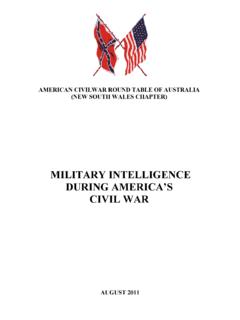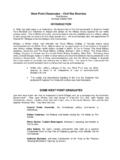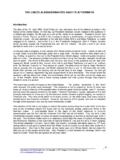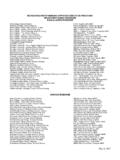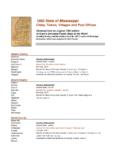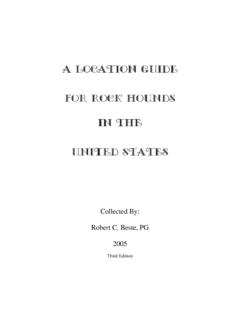Transcription of GEORGE ARMSTRONG CUSTER - Civil War Roundtable
1 GEORGE ARMSTRONG CUSTER American Hero or Just a Fool? Paul Kensey Meeting April 2004 Introduction GEORGE ARMSTRONG CUSTER was arguably the best known of all general officers of the US army in the 19th Century or, rather, CUSTER the Legend was. Star of many motion picture epics, known more for his death than his life, standing Under the flag of the 7th Cavalry, pistol and sabre in hand, long golden hair blowing in the wind, his blue eyes facing the encircling hostile Indians and finally to die with his boots on . He was a most controversial man. In researching the life of GEORGE ARMSTRONG CUSTER you find that what has been written of him is equally controversial, what is fact - what is fiction? Even his detractors who detested him have never denied that he was vigorous and gallant. He did seem, however, to have been fortuitously noticed by his superiors, many of whom saw in him a vain, ambitious, dynamic, charismatic, but fearless fighter.
2 In this paper I have not attempted to answer the question in the title of the address: American Hero or Just a Fool? Rather, I have presented facts as researched and will leave readers to reach their own conclusions.. Just who was GEORGE ARMSTRONG CUSTER ? His Early Childhood CUSTER was born in New Rumley Ohio on December 5 1839, the eldest son of Emanuel and Maria CUSTER , both in their second marriages and was six years older than his next brother Tom. He was known by many names. The family and friends called him ARMSTRONG or by his baby name Autie, gained from his mispronunciation of ARMSTRONG . At West Point he was called Fanny and Curly because of his shoulder length reddish blonde locks he wore at times.) The Cheyenne called him Hi-es-tsie, which means Long Hair; others Ouchess and Creeping Panther. The Crow called him - Son of The Morning Star.
3 - Who Attacks at Dawn. His troopers had better names: - Hard Ass, Iron Butt and Ringlets. He was a genius at self-promotion, journalists and reporters called him The Boy General with the Golden Locks. The Kusters came from Europe s Rhineland, migrating to the New World in the 18th Century and anglicised their name to CUSTER . He sprang, therefore, from the blue-eyed, long nosed, Germanic race that once trotted arrogantly through the Black Forest. When he was a child his father would dress him in a velvet suit and take him to watch military drills. There, clutching a toy musket, he watched as soldiers trained for war with Mexico. He once cried out My voice is for war. It is no surprise, therefore to read what CUSTER wrote from Virginia in 1863; Oh, could you but have seen some of the charges that were made! While thinking of them I cannot but exclaim Glorious War! I gave the Command Forward!
4 And I never expected to see a prettier sight. I frequently turned in my saddle to see the glittering sabres. Though CUSTER was born in Ohio, much of his boyhood was spent with his stepsister Lydia and brother-in-law David Reed at Monroe, Michigan and educated there at the New Dublin School. Hence the mistaken belief that he was a Wolverine (a resident of Michigan). Following his education CUSTER returned to Ohio as a teacher at Beech Point School. In 1856 CUSTER approached Congressman John Bingham (Ohio) for nomination to the United States Military Academy, West Point. Though unsuccessful in 1856 he was selected for appointment the following year. It is frequently and confidently stated, though difficult to prove, that he owed his appointment to West Point through support of the father of a young lady who wished to get him out of his neighbourhood. West Point His attendance at West Point was again fortuitous as his class of June 1861 was cut short, due to the outbreak of war just two months earlier.
5 The expanding Union Army was desperate for officers, otherwise it is generally believed that he would not have graduated at all. Given to pranks and lapses in scholarship, he graduated at the bottom of his class (34/34). He had accumulated 726 demerits, which placed him comfortably behind Cadet GEORGE Watts who graduated second last with 695 demerits. Patrick Henry O Rourke, the top graduate, might have become famous but for the fact he was killed at Gettysburg. Assessed as a below average cadet CUSTER was considered profane, libidinous, alcoholic and according to a classmate: It was alright with him whether he knew his lessons or not; he did not let it trouble him. West Point had never been afflicted with a less promising pupil . CUSTER himself stated that future cadets might study his days at West Point as an example to be avoided. Just prior to graduation, while as duty officer, he failed to break up a fight between two cadets.
6 He was subsequently Court Martialled and was under detention at the time of his graduation and did not attend the ceremonies. Promotions Much has been said and written about his rapid rise through the officer ranks however, this was not uncommon during the Civil War. Upon graduation CUSTER was commissioned as a 2nd Lieutenant into the 2nd Cavalry Regiment and later 5th Cavalry Regiment. He was detached from the Regiment to the Headquarters of the Army Commander, Lieutenant General Winfield 2 Scott to carry dispatches to General Irwin McDowell who was at that time at Centreville preparing for the battle of First Manassas. CUSTER was subsequently transferred to the staff of General GEORGE B McClellan for duty as a topographical engineer. His academic career at West Point would normally have precluded him to such an appointment. In 1862, however, nothing was normal.
7 Trained engineers were few and far between and a West Point graduate, regardless of his academic standing, was better than no engineer at all. 2Lt CUSTER was placed under command of General William (Baldy) Smith where his first detail was digging graves. Civil War maps did not need to be terribly accurate as the armies fought opposite each other. What was of considerable importance was the ground, the woods, pastures, cornfields, the direction and size of watercourses and roads, as well as the location and size of enemy forces. McClellan s cautious siege-like tactics in his Peninsular Campaign in the spring of 1862 had a special need for engineers. Here CUSTER showed all the characteristics of a natural born topographer. This appointment would stand him in good stead for his future. Historians point out that the love of earth invigorated CUSTER , as it did another great Civil War General, William Tecumseh Sherman.
8 It has been said: - They both loved the earth as a sailor loves the sea. Throughout his career, CUSTER had a marvellous sense of topography. Noted as a superb pioneer and guide, he led columns from the front and had an instinctive, uncanny sense of direction, as well as a knack for locating practical routes of march, the result of his initial appointment as a topographical engineer. On one reconnaissance ride with General John Cross Barnard, McClellan s Chief Engineer, the general remarked he would like to know depth of the Chickahominy River to see if it could be forded. His staff not responding, CUSTER plunged in, rode across and called out: That s how deep it is, General CUSTER then picked his way across to the opposite bank. The mission complete, but notwithstanding - he then crept through the bush until he located Rebel pickets guarding the river crossing.
9 He surprised them, captured them, hopped back on his horse and retraced his steps with his prisoners to the surprised and impressed Barnard. General McClellan hearing of CUSTER s exploits spoke to the wet and dirty Second Lieutenant. Instantly; McClellan took a liking to the young officer and offered him a posting on his headquarters as an ADC in the temporary rank of captain in the Regular Army. As a consequence CUSTER , although a substantive Lieutenant only ever wore the gold bar of a Second Lieutenant and never the silver bar of a First Lieutenant. On the 5th June 1862, just twelve months after graduation, Captain CUSTER s meteoric rise to fame had commenced. Following General Meade s replacement of General Hooker after the Chancellorsville debacle. Meade advised General Halleck in Washington that he would shake up the command of his cavalry in the hope of improving its efficiency.
10 After consulting the Cavalry Commander General Pleasanton and accepting his recommendations. Meade wired Halleck an unheard-of request: - To promote - in one jump - three brilliant young officers from the rank of captain to that of brigadier general . These officers were: Elon J. Farnsworth, 8th Illinois Cavalry Wesley Merritt, 2nd US Cavalry and GEORGE A. CUSTER , 5th US Cavalry. 3 Either Halleck approved in record time, or else Meade went ahead without his permission, for within a matter of hours Pleasanton had three new generals. CUSTER and Farnsworth were assigned to brigades of the Third Division to be commanded by Brigadier General Judson Kilpatrick, who was known more for his reckless bravery than his brains. CUSTER s promotion to Brigadier General, United States Volunteers, to date June 29 1863, two years after graduation, was even more unusual in that he was in fact only a substantive lieutenant.
